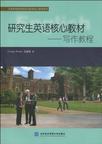研究生英语核心教材
2009-10
对外经济贸易大学出版社
布雷恩(Braine,G.),王俊菊 著
175
无
Introduction to Academic Writing is based on the premise that students of English as a foreign language (EFL) write best when they are given the opportunity to explore topics that motivate them. In our writing classes, we observe how students draw on their experiences to handle such topics with confidence. This book introduces students to academic writing through a sequenced set of assignments that help them to move from personal, expressive writing to informative and persuasive writing. The use of source material, including summary, paraphrase, quotation, and documentation, is emphasized in the informative and persuasive writing assignments. The book stresses writing as a process and e.ncourages the use of collaborative learning strategies as well as individual activities. Therefore, this bookis mainly for students enrolled in English writing courses. It is designed for graduates from non-English majors, also suitable for English majors, both freshmen and sophomores. Students who want to study abroad in English-speaking countries will also find this book useful because good writing skills are essential for success in courses and examinations in an academic setting. ORGANIZATION OF THE BOOK Introduction to Academic Writing is divided into 10 chapters that form two major sections. The first section, Chapters 1 to 4, provides an overview of academic writing. The focus of these chapters is on the writing process, guiding the reader, and effective sentences. In these chapters, the students review writing principles learned in previous courses. The chapters contain many explanations, examples, and exercises so that students and instructors can select specific areas for emphasis. The next section, Chapters 5 to 10, is the heart of the book, introducing and developing a portfolio of writing on a chosen research topic. The assignments range from writing based on the students personal experience and opinions, to informative and persuasive papers that include information obtained from library and other sources. The chapters in this section also discuss methods of development for these papers. Frequent exercises and readings reinforce the concepts taught in these chapters. The final chapter shows students how to apply the writing techniques they have learned in the book to essay examinations.
我国研究生教育迅猛发展,非英语专业研究生英语教学面临新的挑战。为培养新时期合格的外语人才,根据全国高等院校研究生外语教学研究会2007年出台的修订大纲《非英语专业硕士/博士学位研究生英语教学基本要求(试行)》,我们联合上述院校的骨干教师编写了这套适用于我国各地区全日制研究生使用的“全国高等院校研究生核心教材系列”。 本套教材由《研究生英语核心教材——综合教程(上)》、《研究生英语核心教材——综合教程(下)》、《研究生英语核心教材——听说教程》、《研究生英语核心教材——写作教程》、《研究生英语核心教材——翻译教程》组成。 本套教材编写的基本原则是注重培养学生的语言交际能力。《非英语专业硕士/博士学位研究生英语教学基本要求(试行)》辨证地阐述了语言学习和能力培养的关系,提出研究生英语教学应“确保语言基本功训练,但以培养学生语言交际能力为主要目标。”本套研究生英语教材,其选材、编写到练习的设计,都体现了“扎实的基础训练,突出的能力培养”的目标。
Chapter 1 English Composition and the Chinese Student THE ENGLISH LANGUAGE YOUR WRITING STRENGTHS WHAT ARE THE CHALLENGES? GAINING CONFIDENCE IN WRITING READING AND WRITING HOW THIS BOOK IS ORGANIZED READINGSChapter 2 Planning to Write STEP ONE: PLANNING STEP TWO: RESEARCH STEP THREE: DRAFTING STEP FOUR: REVIEWING AND REVISINGChapter 3 Guiding the Reader THESIS STATEMENT PARAGRAPHING TRANSITIONS OUTLINING INTRODUCTIONS AND CONCLUSIONS READINGSChapter 4 Writing Clearly READING ENGLISH A READABLE STYLE COMMON GRAMMA TICAL PROBLEMSChapter 5 Developing a Portfolio of Your Writing RESEARCH TOPICS SAMPLE PORTFOLIOSChapter 6 Writing on Your Experiences PURPOSE AND AUDIENCE METHODS OF DEVELOPMENT ASSIGNMENT 1:EXPRESSING KNOWLEDGE AND OPINIONS READINGS PLANNING/SELF-EVALUATION OF DRAFT PEER REVIEW REVISIONChapter 7 Using and Acknowledging Resources USING THE LIBRARY SUMMARY, PARAPHRASE, AND QUOTATION ACKNOWLEDGING SOURCESChapter 8 Writing to Inform PURPOSE AND AUDIENCE RESEARCH PROPOSAL AND WORKING BIBLIOGRAPHY UNDERSTANDING FACTS AND ISSUES METHODS OF DEVELOPMENT USING GRAPHICS ASSIGNMENT 2 — WRITING TO INFORM READINGS PLANNING/SELF-EVALUATION OF DRAFT PEER REVIEW REVISIONChapter 9 Writing to Persuade PURPOSE AND AUDIENCE METHODS OF DEVELOPMENT RESEARCH PAPER FORMAT ASSIGNMENT 3 — WRITING TO PERSUADE PROGRESS REPORT READINGS PLANNING/SELF-EVALUATION OF DRAFTChapter 10 Answering Essay Examinations PREPARING FOR AN ESSAY EXAM: THE LONG VIEW PREPARING FOR AN ESSAY EXAM: CLOSE TO TEST TIME TAKING THE EXAM SAMPLE QUESTIONS AND ANSWERS
In recent years, the number of students attending universities in China has grown rapidly. This is mainly a result of an increase in the standard of living in China, as well as recognition by students of the importance of a university education. One challenge facing all students, no matter what their language or province of origin, is the need to develop communication skills that will foster understanding among people. The ability to communicate effectively, orally and in writing, is also essential to academic and professional success. Introduction to Academic Writing will introduce you to an important form of communication, the academic writing you will need for your coursework. It will also lay the foundation for the professional writing you might later do on the job. You already know much about writing from all that you have learned in your first language and in previous English courses you have taken. What you learn now will build on your strengths and add skills to make you an accomplished academic writer. Before discussing your writing strengths and the challenges of academic writing, let us pause to describe this fascinating language which has brought us together, English. TI-IE ENGLISH LANGUAGE In the 16th century, during Shakespeares time, English had only about 3 million speakers, and most of them lived in England. French, German, Italian, and Spanish languages all had more speakers. Today, about 370 million people speak English as their first language and about 1,000 million speak it as a second or foreign language, with varying degrees of proficiency. Next to Chinese, English is the most widely spoken language in the world: Moreover, English surpasses Chinese as a global language. The majority of the worlds newspapers, magazines, and books are written in English. About 80% of computer texts and 70% of scientific papers are also written in English.

无
很薄一本书,泛泛而而谈,而且和另一本这个作者写的书《大学英语写作》内容有很大的重复,不值得购买,那一本也不值得购买,给人的感觉就是一本书,两个封面